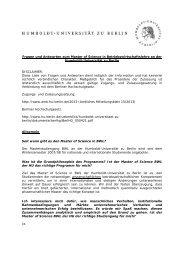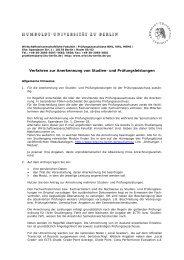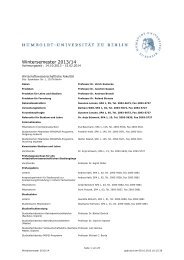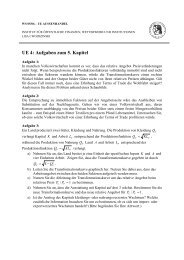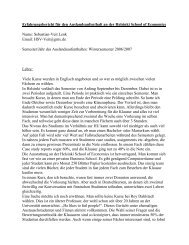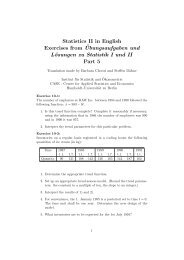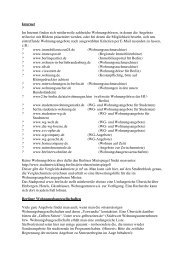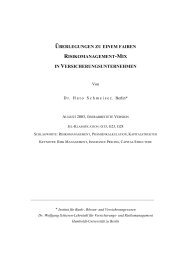Master Thesis - Humboldt-Universität zu Berlin
Master Thesis - Humboldt-Universität zu Berlin
Master Thesis - Humboldt-Universität zu Berlin
Create successful ePaper yourself
Turn your PDF publications into a flip-book with our unique Google optimized e-Paper software.
Writing in real terms and substracting γ p ˆP<br />
C<br />
t−1 from the both terms of the<br />
equation:<br />
ŵ t + ˆP t<br />
C C<br />
−γ p ˆP<br />
t−1 = (1−ξ w )(ŵt ∗ + ˆP t<br />
C<br />
−γ p ˆP<br />
C<br />
t−1 )+ξ w (ŵ t−1 + ˆP C<br />
t−1−γ p ˆP<br />
C<br />
t−2 ) (57)<br />
Combining the two equations gives us the low of motion for the real wages:<br />
ŵ t =<br />
β<br />
1 + β E tŵ t+1 + 1<br />
1 + β E tŵ t−1 + β<br />
1 + β E tˆπ t+1 − 1 + βγ w<br />
1 + β E tˆπ t + γ w<br />
1 + β E tˆπ t−1<br />
1 (1 − βξ w )(1 − ξ w )<br />
−<br />
[ŵ<br />
ξ w (1 + β) 1 + (1+λw)σ t − σ l ˆLt − 1<br />
l<br />
1 − h (Ĉt − Ĉt−1) − ˆτ t c − ˆτ t] l + ˆλ w,t<br />
λ w<br />
(58)<br />
5.2 Intermediate firms: Optimization problem<br />
The<br />
∫<br />
domestic intermediate firm chooses D t and y t to maximize profits, Pt<br />
D D t −<br />
1<br />
P j<br />
0 t y j t . From the cost minimization, one obtains the demand for each intermediate<br />
producer:<br />
(<br />
y j t = D t G ′ −1 P j<br />
t<br />
Pt<br />
D<br />
∫ 1<br />
0<br />
G ′ (y j t /D t )(y i t/D t )dj<br />
)<br />
(59)<br />
Before proceeding further, we want to explain shortly the implications<br />
of variable elasticity of demand, as displayed by Kimball (1995). The assumption<br />
on G imply that the demand for input y j t is a decreasing function<br />
in its relative price. In other words, the firm must take into account when<br />
optimizing their objective function that setting a higher price might result<br />
into lower profits due to decreasing demand for their goods. The elasticity<br />
of demand for the output of intermediate goods is not explicitly modelled<br />
by the authors. We follow Eichenbaum and Fisher (2004) and define<br />
it as η(x) = −G ′ (x)/xG ′′ (x), where x = y j t /D t In our model the elasticity<br />
of demand for a given intermediate good is η(x) = (λj p,t +1)<br />
, with λ p,t<br />
the variable mark-up of the firm, defined as η(1)/(η(1) − 1) − 1. It follows<br />
26<br />
λ j p,t




